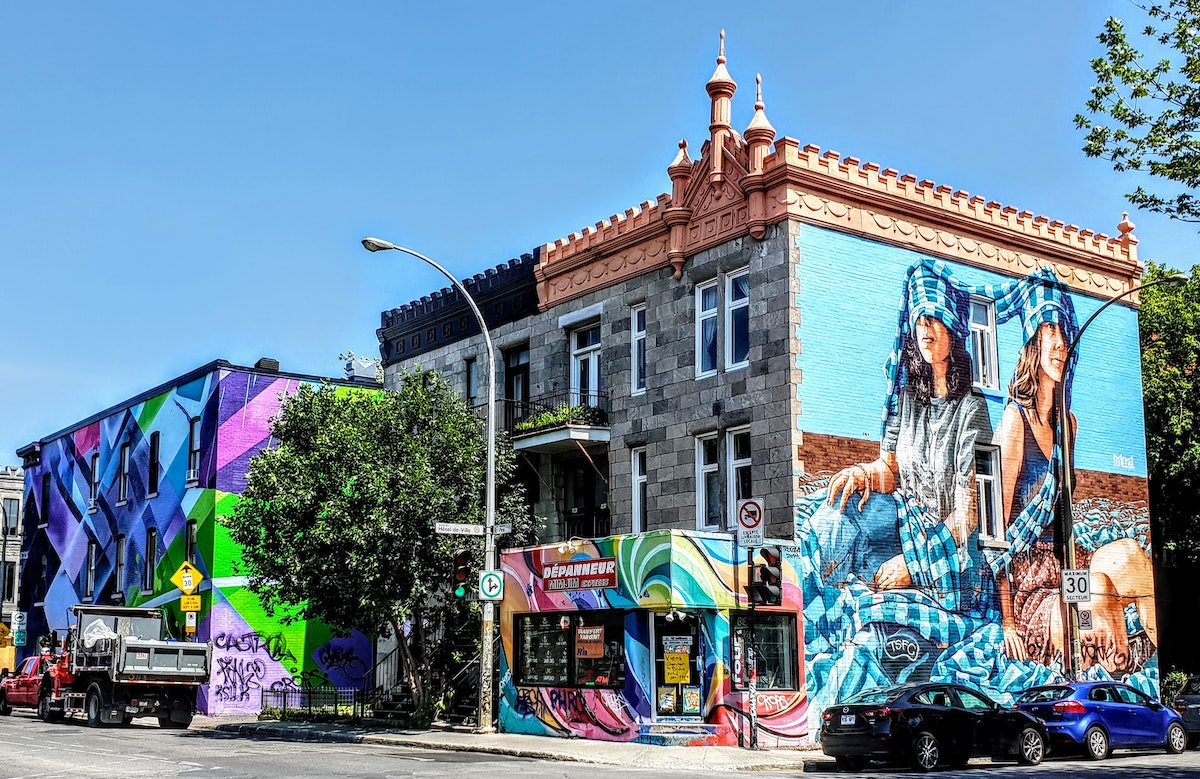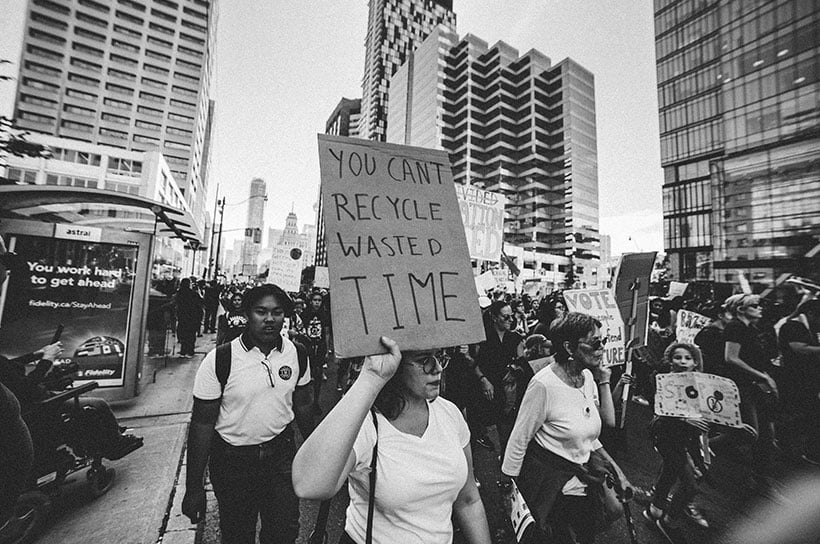As Canada's cities race against climate change, the urgency of finding solutions intensifies
Over the last six months, Canada's National Observer has been looking into what's working and what's failing in cities across Canada as they rise to the challenge of tackling climate change. In a 13-part series, we will be taking you across the country, province by province, for a look at how cities are meeting the climate emergency with sustainable solutions.
As a species, we are facing an unprecedented crisis. I’ve spent the last 20 years tackling climate change within Chicago and Vancouver city governments and I know change is already upon us. To reduce global warming, cities have become leaders in curbing greenhouse gas emissions. They are on the front lines dealing with floods, heat waves, extreme storms and rising seas, and must be ready for the changes that are coming. The lives of their residents rely on it.
Since the 1980s, we have recognized human activity is changing the climate. In 2015, national governments around the globe reached the Paris Agreement, which set the target of reducing carbon pollution to ensure we don’t increase temperatures on the planet by more than two degrees Celsius above pre-industrialization levels. We are already at 1.2 degrees C. Unfortunately, with the pledges made under the agreement, we are on track for about 2.8 degrees C by the end of the century.

As the Intergovernmental Panel on Climate Change (IPCC) states: “Without increased and urgent mitigation ambition in the coming years, leading to a sharp decline in greenhouse gas emissions by 2030, global warming will surpass 1.5 C in the following decades, leading to irreversible loss of the most fragile ecosystems, and crisis after crisis for the most vulnerable people and societies.”
There is scientific consensus that we need to limit temperature increases by 1.5 degrees C. Based on a 2018 IPCC report, keeping below a 1.5 C increase in temperature will require a 50 per cent reduction in our climate pollution by 2030 and getting to near-zero emissions by 2050.
Recently, our prime minister joined the U.S. president to announce the two countries would work together to tackle climate change. The national commitment is critical, but without harnessing, empowering and supporting local communities, it won’t bear fruit.
Making the case for local government action
Canada has spectacular cities. They are our economic engines and hotbeds of innovation. Unfortunately, they are also overburdened, under-resourced and highly vulnerable to the impacts of climate change. Our cities are at risk. As is clear from recent Ottawa River floods, Fort McMurray fires or hazardous air quality in Vancouver from wildfire smoke, urban areas are taking the brunt of the damage. With over half the world’s population living in urban areas (in Canada, it’s over 80 per cent) and over 70 per cent of climate pollution emanating from them, it’s clear we won’t beat climate change without city leadership.
The majority of our carbon pollution in Canadian cities comes from burning gas and diesel for transportation, natural gas for heating our homes and, in certain places, coal to produce the electricity used in our buildings. Thankfully, Canadian cities can act fast, are taking this problem seriously and are using their tools to address the primary sources of carbon pollution.


Getting around

The way we design and build out our urban centres and how we manage public spaces allocated for transportation (roads, sidewalks, bike lanes) can have a significant impact on how people get around and the amount of pollution produced.
Almost 20 years ago in Chicago, I was involved in one of the first car-sharing efforts in the world. An innovative “think-and-do tank” called the Center for Neighborhood Technology launched a small initiative to allow people to share rather than own a vehicle.
I was in the mayor’s office at the time, and the success of this fledgling initiative relied on the city partnership. There were complications with parking restrictions and other regulations that hampered the pilot program. It also needed to access federal funds that were only available to cities. We partnered with them and together we demonstrated car sharing could work.
Robust metrics showed one car-sharing vehicle reduced the number of privately owned vehicles by 17. Through that pilot program, and others, the mobility-sharing economy was born. Now there are over 23,000 shared cars across North America.
The bike-sharing, scooter-sharing and ride-hailing sectors have similarly exploded and are transforming our communities, providing more ways for people to get around without needing a private car. Across North America, proactive municipal leadership has helped the disruptive sharing economy to flourish.
Public transit plays a critical role in reducing carbon pollution from our day-to-day trips around town. Unfortunately, building these systems is very expensive and can take decades. To demonstrate the benefits of public transportation without the multibillion-dollar investments, Winnipeg is using bus rapid transit (BRT). It’s an approach that has proven successful in cities around the world. System users get many of the benefits of a train system, like stations and dedicated lanes, without needing to build an expensive rail network.

Our buildings

Most of the energy used in cities powers our buildings. How we design and build them can have a drastic impact on the amount of energy required to operate them. A new city hall in Sackville, N.B., was built using geothermal wells that use the Earth’s temperatures to heat and cool, green roofs to absorb stormwater and solar panels to generate energy for use in the building, thereby demonstrating that cities are leading the way in their own buildings.
Some Canadian cities have looked to leading cities in Europe to learn how to make our new buildings more energy efficient. We have picked up a new methodology for building called “Passive House” that is popular in Europe. Using this approach, a building is constructed with an energy-efficient envelope comprised of thicker and more insulated outer walls. The result is buildings that require 80 to 90 per cent less energy to heat and cool.
It’s a little more expensive to build this way, but the savings pay back pretty quickly. So, why isn’t everyone doing it? Well, city regulations have inadvertently discouraged this type of construction because of building separation and square footage allowances. By changing these regulations, cities like Vancouver are making these more efficient ways of building far more attractive.
Meanwhile, Toronto is utilizing these techniques to retrofit its older affordable highrise buildings to make them more energy efficient and affordable to heat and cool. With super-insulated buildings, you can harness new technologies like air source heat pumps to efficiently heat or cool buildings.


Our energy

Heating buildings accounts for most of the carbon pollution in our cities. That generally comes from burning natural gas. While cities don’t control where power is generated or how it is produced, some cities are finding ways to produce less carbon-intensive power, partly to ensure there is a reliable energy source for their own communities in the event of emergencies.
One way they are doing so is by supporting renewable energy production. Summerside, in Prince Edward Island, partnered with the federal government and built a solar and battery system that produces over 60 per cent of its electricity from the sun, thereby drastically reducing its carbon pollution.
In Vancouver, the city built a system that uses the heat from large sewer pipes. When you run your dishwasher or take a shower, hot water goes into the sewers, which means that sewer water is quite warm. Vancouver’s system, which was modelled on a system in Japan, takes the heat out of a large sewer pipe and distributes that warmth through a district energy system to heat an entire neighbourhood. People whose heat or hot water are produced using this waste heat from the sewers pay an equivalent rate to those using natural gas, but their carbon pollution is about 75 per cent lower.
Now, there are multiple district energy systems being built throughout the region by cities and private developers. A similar system in Toronto utilizes the cold temperatures of water deep in Lake Ontario to cool many of the downtown buildings, and the city’s climate plans call for the expansion of district energy systems.
Cutting emissions, improving lifestyles
When cities take bold action to reduce carbon pollution through better design, it works. Since 2007, carbon pollution in Vancouver has been reduced by nine per cent while population has grown by 11 per cent and jobs in the community have risen by 14 per cent. Thanks to multi-modal “bike” lanes designed for even the most cautious biker, transportation investments and numerous bike- and car-sharing options, the number of people living and working in the downtown core has increased by 75 per cent since the 1990s. Yet car trips into and out of downtown have been reduced by 25 per cent.
Achieving these results doesn’t come without controversy and some setbacks along the way. But even failures are necessary as we figure this out.

Argue globally, act locally
Ambitious national climate targets are critical, but they won’t be achieved without cities. Municipal governments are often described as the “lowest” level government, yet municipalities are uniquely positioned to achieve results. Politically, climate change is a hot potato, and as a result, action on the national and international scale has been intermittent. Meanwhile, municipalities are steadily working to reduce emissions and are delivering real results.
As the stories in this Canada's National Observer series highlight, these actions are taking place in large and small cities across the country. By making commitments and taking action, local communities inspire their residents and businesses and become more competitive and resilient to a changing economy and climate. Ultimately, by being proactive and addressing climate change, our communities are improving the quality of life for their residents.
While municipalities have many tools to tackle climate change, they are kind of underwater (pun intended). They have taken on considerable new responsibilities over the last few decades. People working in government call it downloading. It’s when one level of government passes a responsibility down a level, generally without appropriate funding sources to handle the extra burden.
In many instances, cities have taken on these new roles voluntarily or out of a sense of desperation to protect their quality of life. Addressing homelessness, mental health, addictions, the opioid crisis and poverty are obligations of provincial and federal governments, yet our cities are spending billions of dollars to tackle those challenges.
Cities in Canada own and operate over 60 per cent of the public infrastructure in the nation, while on average, they only get 12 per cent of taxes levied in the country, yet they are tackling the critical issues of our time. I worry the growing climate crisis will be the straw that breaks the camel’s back.
We need our cities to continue to tackle climate change, yet with COVID-19 and critical social issues requiring immediate attention, cities are starved for resources. Now more than ever, we need the federal and provincial governments at the table to ensure that our cities, large and small, have the tools and resources to adequately adapt their communities to the imminently changing climate, as well as to proactively reduce carbon pollution. Thankfully, important conversations about the distribution of resources and tools between levels of government are being furthered by the Canadian Urban Institute and the Federation of Canadian Municipalities.
Canadian cities, including large ones like Toronto and smaller ones like Vancouver, are being held accountable by their residents to tackle climate change, but their success in doing so will be dependent on their partners in the federal and provincial governments working with them. National emissions-reduction targets will depend on it.

Our cities can’t do this alone. Now more than ever, the federal and provincial governments must support and enable cities. As the stories in this National Observer series highlight, Canadian cities are ready. They can reduce their emissions and protect their residents. Let’s hope they have the resources to succeed.
Wow, great summary of the
Wow, great summary of the city/carbon situation and some of the solutions being tried. Thanks! Hopefully the reality that burning fossil gas for heating air and water is the biggest climate pollution problem in Canadian cities becomes better known by the public, as this is an easy fix by switching to electricity. Huge numbers of homes and buildings in Canada have been all-electric heated for decades now.
Switching to electricity is
Switching to electricity is not an "easy fix", it is capital intensive for the homeowner and requires a major investment in time, money and renovation. For example, replacing a gas furnace with a heat pump is conceptually simple, but in terms of design and execution, beyond the DIY implication of a "simple fix", even though it is an excellent solution. Going the next step and generating one's own electricity is even more money and expertise intensive; not for the faint of heart or shallow wallet.


Comments